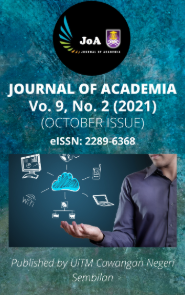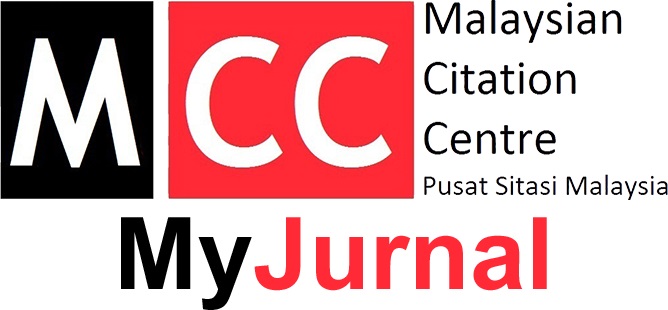SYNTHESIS, CHARACTERISATION AND CORROSION INHIBITION SCREENING OF Co(II) DITHIOCARBAMATE COMPLEXES IN HCl AND H2SO4
Keywords:
acid, corrosion inhibitor, dithiocarbamate, mild steelAbstract
Most industries use acids during cleaning processes where they may cause severe corrosion attacks on
metal surfaces. This study utilised a corrosion inhibitor to reduce the corrosion rate. Cobalt(II) N
methylcyclohexylamine dithiocarbamate, Co[MeCycHexdtc]2 and cobalt(II) N-ethylcyclohexylamine
dithiocarbamate, Co[EtCycHexdtc]2 were synthesised by using the in-situ method with a molar ratio of
2:2:1 (carbon disulphide:amine:metal salt) in cold ethanolic solution and characterised by using the
Fourier Transform Infrared-Attenuated Total Reflectance (FTIR-ATR) and Ultraviolet-Visible (UV-Vis)
spectroscopies. In the FTIR-ATR analysis, the presence of dithiocarbamate moiety was proven by the
data shown with the presence of a new specific stretching bands, thioureide band, υ(C
in the range of 1478–1481 cm-1 and υ(C
N) which is found
S) in 1010-1012 cm-1 of the spectra in both Co(II) complexes.
For UV-Vis analysis, the Co(II) complexes showed two transitions, π→π* and n→π* transitions, which
indicated that the coordination between metal ions and dithiocarbamates ligands has successfully formed.
The presence of peaks above 400 nm confirmed the d-d transition of Co(II) complexes. Furthermore, mild
steel corrosion inhibition screening was studied using two corrosive media (1 M HCl and 1 M H2SO4)
with and without varied inhibitor concentrations. As the inhibitor concentration increased, the efficiency
of the corrosion inhibitor also increased at a constant temperature.
References
Adeyemi, J. O., & Onwudiwe, D.C. (2018). Organotin(IV) dithiocarbamate complexes: Chemistry and biological
activity. Molecules, 23, 2571-2597. https://doi.org/10.3390/molecules23102571
Al-Obaidy, G. S., Ibraheem, K. R., & Mesher, M. F. (2020). Metal complexes derived from dithiocarbamate ligand:
Formation, spectral, characterization and biological activity. Systematic Review Pharmacy, 11(6), 360-368.
https://doi.org/10.31838/srp.2020.6.57
Bahrami, M. J., Hosseini, S. M. A., & Pilvar, P. (2010). Experimental and theoretical investigation of organic
compounds as inhibitors for mild steel corrosion in sulfuric acid medium. Corrosion Science, 52, 2803-2793.
https://doi.org/10.1016/j.corsci.2010.04.024
Chigondo, M., & Chigondo, F. (2016). Recent Natural Corrosion Inhibitors for Mild Steel: An Overview. Journal
of Chemistry, 2016, 1-7. https://doi.org/10.1155/2016/6208937
Dariva, C. G., & Gallo, A. F. (2014). Corrosion inhibitors-principles, mechanisms and applications. Developments
in Corrosion Protection, 366-375. http://dx.doi.org/10.5772/57255
Keles, M., Keles, H., & Emir, D. M. (2015). Pd(II) complexes of Schiff Bases and their application as catalysts in
Mizoroki-Heck and Suzuki-Miyaura cross-coupling reactions. Application of Organometallic Chemistry, 29, 543
https://doi.org/10.1002/aoc.3329
Khan, S. A., Ahmad, W., Munawar, K. S., & Kanwal, S. (2018). Synthesis, spectroscopic characterization and
biological evaluation of Ni(II), Cu(II) and Zn(II) complexes of Diphenyldithiocarbamate. Indian Journal of
Pharmaceutical Sciences, 80(3), 480-488. https://doi.org/10.4172/pharmaceutical-sciences.1000381
Latif, N. S., Ghazali, S. A., Abdullah, E. N., Lahuri, A. H., Ngatiman, M. F., & Dzulkifli, N. N. (2018). Synthesis,
structural, density functional theory, and X-ray diffraction study of Zn(II) N-isopropylbenzyldithiocarbamate: Anti
corrosion
screening
in
acid
https://doi.org/10.22146/ijc.34703
media. Indonesian
Journal
of
Chemistry, 18(4),
-765.
Li, F., Bai, M., Wei, S., Jin, S., & Shen, W. (2019). Multidimension insight involving experimental and in Silico
investigation into the corrosion inhibition of N, N-dibenzyl dithiocarbamate acid on copper in sulfuric acid
solution. Industrial
&
Engineering
https://doi.org/10.1021/acs.iecr.9b00371
Chemistry
Research, 58(17),
-7178.
Loto, R. L. (2018). Surface coverage and corrosion inhibition effect of Rosmarinus officinalis and zinc oxide on the
electrochemical performance of low carbon steel in dilute acid solutions. Results in Physics, 8, 172-179.
https://doi.org/10.1016/j.rinp.2017.12.003
use
as
precursors
Nqombolo, A., & Ajibade, P. A. (2016). Synthesis and spectral studies of Ni(II) Dithiocarbamate complexes and
their
for
https://doi.org/10.1155/2016/1293790
and
their
nickel
sulphides
Nanocrystals. Journal
of
Chemistry,
Odularu, A. T., & Ajibade, P. A. (2019). Dithiocarbamates: Challenges, control, and approaches to excellent yield,
characterization,
biological applications. Bioinorganic Chemistry and Applications, 1-15.
https://doi.org/10.1155/2019/8260496
Okafor, P.C., Ebenso, E.E., & Ekpe, U.J. (2004). Inhibition of The Acid Corrosion of Aluminium by Some
Derivatives of Thiosemicarbazone. Bulletin of the Chemical Society of Ethiopia, 18(2), 181-192.
https://doi.org/10.4314/bcse.v18i2.61442
Raja, P. B., Ismail, M., Ghoreishiamiri, S., Mirza, J., Ismail, M. C., Kakooei, S., & Rahim, A. A. (2016). Reviews
on corrosion inhibitors: A short view. Chemical Engineering Communications, 203(9), 1145-1156.
https://doi.org/10.1080/00986445.2016.1172485
Rani, B. E., & Basu, B. B. (2012). Green inhibitors for corrosion protection of metals and alloys: An
overview. International Journal of Corrosion, 1-15. https://doi.org/10.1155/2012/380217
Sehmi, A., Ouici, H. B., Guendouzi, A., Ferhat, M., Benali, O., & Boudjellal, F. (2020). Corrosion inhibition of
mild steel by newly synthesized Pyrazole Carboxamide derivatives in HCl acid medium: Experimental and
theoretical studies. Journal of The Electrochemical Society, 167(15), 1-19. https://doi.org/10.1149/1945
/abab25
Sivasekar, S., Ramalingam, K., & Rizzoli, C. (2015). Metal dithiocarbamate precursors for the preparation of a
binary sulfide and a pyrochlore: Synthesis, structure, continuous shape measure and bond valence sum analysis of
antimony(III) dithiocarbamates. Polyhedron, 85, 598-606. https://doi.org/10.1016/j.poly.2014.09.028
Downloads
Published
Issue
Section
License
Copyright (c) 2021 Journal of Academia

This work is licensed under a Creative Commons Attribution-NonCommercial-NoDerivatives 4.0 International License.












